Prediction of Solar Irradiance over the Arabian Peninsula: Satellite Data, Radiative Transfer Model, and Machine Learning Integration Approach
Abstract
:1. Introduction
2. Theoretical Background
2.1. Residual Networks (ResNets)
2.2. Radiative Transfer Model (RTM)
2.3. Moderate Resolution Imaging Spectroradiometer (MODIS)
3. Model Setup and Data Collection
3.1. ResNet Model Setup
3.2. Dataset
4. Results and Discussion
4.1. Exploratory Data Analysis
4.1.1. RTM Model Verification
4.1.2. Monthly Variability of Solar Irradiance
4.2. Effect of Major Dust Events
4.3. ResNets Prediction Analysis
5. Conclusions
Author Contributions
Funding
Institutional Review Board Statement
Informed Consent Statement
Data Availability Statement
Acknowledgments
Conflicts of Interest
References
- Solangi, K.H.; Islam, M.R.; Saidur, R.; Rahim, N.A.; Fayaz, H. A Review on Global Solar Energy Policy. Renew. Sustain. Energy Rev. 2011, 15, 2149–2163. [Google Scholar] [CrossRef]
- Hyperwall: Monthly Solar Insolation. Available online: https://svs.gsfc.nasa.gov/cgi-bin/details.cgi?aid=30367 (accessed on 27 October 2021).
- Moreno, L.E.G. Concentrated Solar Power (CSP) in DESERTEC—Analysis of Technologies to Secure and Affordable Energy Supply. In Proceedings of the 6th IEEE International Conference on Intelligent Data Acquisition and Advanced Computing Systems, Prague, Czech Republic, 15–17 September 2011; Volume 2, pp. 923–926. [Google Scholar]
- ACWA POWER|Sakaka PV IPP. Available online: https://acwapower.com/en/projects/sakaka-pv-ipp/ (accessed on 10 November 2021).
- Farahat, A.; Kambezidis, H.D.; Almazroui, M.; Ramadan, E. Solar Potential in Saudi Arabia for Southward-Inclined Flat-Plate Surfaces. Appl. Sci. 2021, 11, 4101. [Google Scholar] [CrossRef]
- Farahat, A.; Kambezidis, H.D.; Almazroui, M.; Al Otaibi, M. Solar Potential in Saudi Arabia for Inclined Flat-Plate Surfaces of Constant Tilt Tracking the Sun. Appl. Sci. 2021, 11, 7105. [Google Scholar] [CrossRef]
- Kambezidis, H.D.; Farahat, A.; Almazroui, M.; Ramadan, E. Solar Potential in Saudi Arabia for Flat-Plate Surfaces of Varying Tilt Tracking the Sun. Appl. Sci. 2021, 11, 11564. [Google Scholar] [CrossRef]
- Kaufman, Y.J.; Tanré, D.; Boucher, O. A Satellite View of Aerosols in the Climate System. Nature 2002, 419, 215–223. [Google Scholar] [CrossRef] [PubMed]
- Bhattacharya, T.; Chakraborty, A.K.; Pal, K. Effects of Ambient Temperature and Wind Speed on Performance of Monocrystalline Solar Photovoltaic Module in Tripura, India. J. Sol. Energy 2014, 2014, 817078. [Google Scholar] [CrossRef] [Green Version]
- Siddiqui, R.; Bajpai, U. Deviation in the Performance of Solar Module under Climatic Parameter as Ambient Temperature and Wind Velocity in Composite Climate. Int. J. Renew. Energy Res. (IJRER) 2012, 2, 486–490. [Google Scholar]
- Sayyah, A.; Horenstein, M.N.; Mazumder, M.K. Energy Yield Loss Caused by Dust Deposition on Photovoltaic Panels. Sol. Energy 2014, 107, 576–604. [Google Scholar] [CrossRef]
- Vardavas, I.M.; Vardavas, I.; Taylor, F. Radiation and Climate: Atmospheric Energy Budget from Satellite Remote Sensing; Oxford University Press: Oxford, UK, 2011; Volume 138. [Google Scholar]
- Forster, P.; Ramaswamy, V.; Artaxo, P.; Berntsen, T.; Betts, R.; Fahey, D.W.; Haywood, J.; Lean, J.; Lowe, D.C.; Myhre, G. Changes in Atmospheric Constituents and in Radiative Forcing. Chapter 2. In Climate Change 2007. The Physical Science Basis; 2007; Available online: https://www.ipcc.ch/site/assets/uploads/2018/02/ar4-wg1-chapter2-1.pdf (accessed on 10 November 2021).
- Behrendt, T.; Kuehnert, J.; Hammer, A.; Lorenz, E.; Betcke, J.; Heinemann, D. Solar Spectral Irradiance Derived from Satellite Data: A Tool to Improve Thin Film PV Performance Estimations? Sol. Energy 2013, 98, 100–110. [Google Scholar] [CrossRef]
- Sokolik, I.N.; Toon, O.B. Direct Radiative Forcing by Anthropogenic Airborne Mineral Aerosols. Nature 1996, 381, 681–683. [Google Scholar] [CrossRef]
- Miller, R.L.; Tegen, I. Climate Response to Soil Dust Aerosols. J. Clim. 1998, 11, 3247–3267. [Google Scholar] [CrossRef]
- Miller, R.L.; Tegen, I.; Perlwitz, J. Surface Radiative Forcing by Soil Dust Aerosols and the Hydrologic Cycle. J. Geophys. Res. Atmos. 2004, 109. [Google Scholar] [CrossRef]
- Farahat, A. Air Pollution in the Arabian Peninsula (Saudi Arabia, the United Arab Emirates, Kuwait, Qatar, Bahrain, and Oman): Causes, Effects, and Aerosol Categorization. Arab. J. Geosci. 2016, 9, 1–17. [Google Scholar] [CrossRef]
- Farahat, A.; El-Askary, H.; Adetokunbo, P.; Fuad, A.-T. Analysis of aerosol absorption properties and transport over North Africa and the Middle East using AERONET data. Ann. Geophys. 2016, 34, 1031–1044. [Google Scholar] [CrossRef] [Green Version]
- Remer, L.A.; Kleidman, R.G.; Levy, R.C.; Kaufman, Y.J.; Tanré, D.; Mattoo, S.; Martins, J.V.; Ichoku, C.; Koren, I.; Yu, H. Global Aerosol Climatology from the MODIS Satellite Sensors. J. Geophys. Res. Atmos. 2008, 113. [Google Scholar] [CrossRef] [Green Version]
- Alharbi, B.H.; Maghrabi, A.L.; Tapper, N. The March 2009 Dust Event in Saudi Arabia: Precursor and Supportive Environment. Bull. Am. Meteorol. Soc. 2013, 94, 515–528. [Google Scholar] [CrossRef]
- Mohalfi, S.; Bedi, H.S.; Krishnamurti, T.N.; Cocke, S.D. Impact of Shortwave Radiative Effects of Dust Aerosols on the Summer Season Heat Low over Saudi Arabia. Mon. Weather Rev. 1998, 126, 3153–3168. [Google Scholar] [CrossRef]
- Saeed, T.M.; Al-Dashti, H.; Spyrou, C. Aerosol’s Optical and Physical Characteristics and Direct Radiative Forcing during a Shamal Dust Storm, a Case Study. Atmos. Chem. Phys. 2014, 14, 3751–3769. [Google Scholar] [CrossRef] [Green Version]
- Jish Prakash, P.; Stenchikov, G.; Kalenderski, S.; Osipov, S.; Bangalath, H. The Impact of Dust Storms on the Arabian Peninsula and the Red Sea. Atmos. Chem. Phys. 2015, 15, 199–222. [Google Scholar] [CrossRef] [Green Version]
- Bangalath, H.K.; Stenchikov, G. Role of Dust Direct Radiative Effect on the Tropical Rain Belt over Middle East and North Africa: A High-Resolution AGCM Study. J. Geophys. Res. Atmos. 2015, 120, 4564–4584. [Google Scholar] [CrossRef] [Green Version]
- Fawaz, H.I.; Forestier, G.; Weber, J.; Idoumghar, L.; Muller, P.-A. Deep Learning for Time Series Classification: A Review. Data Min. Knowl. Discov. 2019, 33, 917–963. [Google Scholar] [CrossRef] [Green Version]
- Lim, B.; Zohren, S. Time Series Forecasting with Deep Learning: A Survey. arXiv 2020, arXiv:2004.13408. [Google Scholar] [CrossRef] [PubMed]
- Gueymard, C. SMARTS2: A Simple Model of the Atmospheric Radiative Transfer of Sunshine: Algorithms and Performance Assessment; Florida Solar Energy Center: Cocoa, FL, USA, 1995. [Google Scholar]
- Mayer, B.; Kylling, A. The LibRadtran Software Package for Radiative Transfer Calculations-Description and Examples of Use. Atmos. Chem. Phys. 2005, 5, 1855–1877. [Google Scholar] [CrossRef] [Green Version]
- Wu, J.; Zhang, Z.; Ji, Y.; Li, S.; Lin, L. A ResNet with GA-Based Structure Optimization for Robust Time Series Classification. In Proceedings of the 2019 IEEE International Conference on Smart Manufacturing, Industrial & Logistics Engineering (SMILE), Hangzhou, China, 20–21 April 2019; pp. 69–74. [Google Scholar]
- Alzahrani, A.; Shamsi, P.; Dagli, C.; Ferdowsi, M. Solar Irradiance Forecasting Using Deep Neural Networks. Procedia Comput. Sci. 2017, 114, 304–313. [Google Scholar] [CrossRef]
- Benali, L.; Notton, G.; Fouilloy, A.; Voyant, C.; Dizene, R. Solar Radiation Forecasting Using Artificial Neural Network and Random Forest Methods: Application to Normal Beam, Horizontal Diffuse and Global Components. Renew. Energy 2019, 132, 871–884. [Google Scholar] [CrossRef]
- Kylling, A.; Stamnes, K.; Tsay, S.-C. A Reliable and Efficient Two-Stream Algorithm for Spherical Radiative Transfer: Documentation of Accuracy in Realistic Layered Media. J. Atmos. Chem. 1995, 21, 115–150. [Google Scholar] [CrossRef]
- Hatzianastassiou, N.; Fotiadi, A.; Matsoukas, C.; Pavlakis, K.; Drakakis, E.; Hatzidimitriou, D.; Vardavas, I. Long-Term Global Distribution of Earth’s Shortwave Radiation Budget at the Top of Atmosphere. Atmos. Chem. Phys. 2004, 4, 1217–1235. [Google Scholar] [CrossRef] [Green Version]
- Hatzianastassiou, N.; Katsoulis, B.; Vardavas, I. Global Distribution of Aerosol Direct Radiative Forcing in the Ultraviolet and Visible Arising under Clear Skies. Tellus B Chem. Phys. Meteorol. 2004, 56, 51–71. [Google Scholar] [CrossRef]
- Hatzianastassiou, N.; Katsoulis, B.; Vardavas, I. Sensitivity Analysis of Aerosol Direct Radiative Forcing in Ultraviolet—Visible Wavelengths and Consequences for the Heat Budget. Tellus B Chem. Phys. Meteorol. 2004, 56, 368–381. [Google Scholar]
- Hatzianastassiou, N.; Matsoukas, C.; Drakakis, E.; Stackhouse, P.W., Jr.; Koepke, P.; Fotiadi, A.; Pavlakis, K.G.; Vardavas, I. The Direct Effect of Aerosols on Solar Radiation Based on Satellite Observations, Reanalysis Datasets, and Spectral Aerosol Optical Properties from Global Aerosol Data Set (GADS). Atmos. Chem. Phys. 2007, 7, 2585–2599. [Google Scholar] [CrossRef] [Green Version]
- NOAA. Land-Based Station Data|National Centers for Environmental Information (NCEI) Formerly Known as National Climatic Data Center (NCDC)—Google. Available online: https://www.google.com/search?q=.+NOAA%2C+Land-Based+Station+Data+%7C+National+Centers+for+Environmental+Information+%28NCEI%29+Formerly+Known+as+National+Climatic+Data+Center+%28NCDC%29&ei=VnF5YcufIM3bgwfs1afABQ&ved=0ahUKEwjLopqN9erzAhXN7eAKHezqCVgQ4dUDCA4&uact=5&oq=.+NOAA%2C+Land-Based+Station+Data+%7C+National+Centers+for+Environmental+Information+%28NCEI%29+Formerly+Known+as+National+Climatic+Data+Center+%28NCDC%29&gs_lcp=Cgdnd3Mtd2l6EAMyBwgAEEcQsAMyBwgAEEcQsAMyBwgAEEcQsAMyBwgAEEcQsAMyBwgAEEcQsAMyBwgAEEcQsAMyBwgAEEcQsAMyBwgAEEcQsANKBAhBGABQhqECWIahAmCrrwJoAHAFeACAAQCIAQCSAQCYAQCgAQHIAQjAAQE&sclient=gws-wiz (accessed on 27 October 2021).
- Goodfellow, I.; Bengio, Y.; Courville, A. Deep Learning; MIT Press: Cambridge, UK, 2016; Volume 1. [Google Scholar]
- Chu, D.A.; Kaufman, Y.J.; Ichoku, C.; Remer, L.A.; Tanré, D.; Holben, B.N. Validation of MODIS Aerosol Optical Depth Retrieval over Land. Geophys. Res. Lett. 2002, 29, MOD2-1. [Google Scholar] [CrossRef] [Green Version]
- Remer, L.A.; Kaufman, Y.J.; Tanré, D.; Mattoo, S.; Chu, D.A.; Martins, J.V.; Li, R.-R.; Ichoku, C.; Levy, R.C.; Kleidman, R.G. The MODIS Aerosol Algorithm, Products, and Validation. J. Atmos. Sci. 2005, 62, 947–973. [Google Scholar] [CrossRef] [Green Version]
- Roesch, A.; Schaaf, C.; Gao, F. Use of Moderate-Resolution Imaging Spectroradiometer Bidirectional Reflectance Distribution Function Products to Enhance Simulated Surface Albedos. J. Geophys. Res. Atmos. 2004, 109. [Google Scholar] [CrossRef] [Green Version]
- Schaaf, C.B.; Gao, F.; Strahler, A.H.; Lucht, W.; Li, X.; Tsang, T.; Strugnell, N.C.; Zhang, X.; Jin, Y.; Muller, J.-P. First Operational BRDF, Albedo Nadir Reflectance Products from MODIS. Remote Sens. Environ. 2002, 83, 135–148. [Google Scholar] [CrossRef] [Green Version]
- Levy, R.C.; Remer, L.A.; Kleidman, R.G.; Mattoo, S.; Ichoku, C.; Kahn, R.; Eck, T.F. Global Evaluation of the Collection 5 MODIS Dark-Target Aerosol Products over Land. Atmos. Chem. Phys. 2010, 10, 10399–10420. [Google Scholar] [CrossRef] [Green Version]
- Hsu, N.C.; Tsay, S.-C.; King, M.D.; Herman, J.R. Deep Blue Retrievals of Asian Aerosol Properties during ACE-Asia. IEEE Trans. Geosci. Remote Sens. 2006, 44, 3180–3195. [Google Scholar] [CrossRef]
- Levy, R.C.; Mattoo, S.; Munchak, L.A.; Remer, L.A.; Sayer, A.M.; Patadia, F.; Hsu, N.C. The Collection 6 MODIS Aerosol Products over Land and Ocean. Atmos. Meas. Tech. 2013, 6, 2989–3034. [Google Scholar] [CrossRef] [Green Version]
- Wang, Z.; Yan, W.; Oates, T. Time Series Classification from Scratch with Deep Neural Networks: A Strong Baseline. In Proceedings of the 2017 International Joint Conference on Neural Networks (IJCNN), Anchorage, AK, USA, 14–19 May 2017; pp. 1578–1585. [Google Scholar]
- Alwadei, S.; Ahmed, M. On the Sensitivity of Residual Networks for Time Series Classification. In Proceedings of the 2021 1st International Conference on Artificial Intelligence and Data Analytics (CAIDA), Riyadh, Saudi Arabia, 6–7 April 2021; pp. 234–239. [Google Scholar]
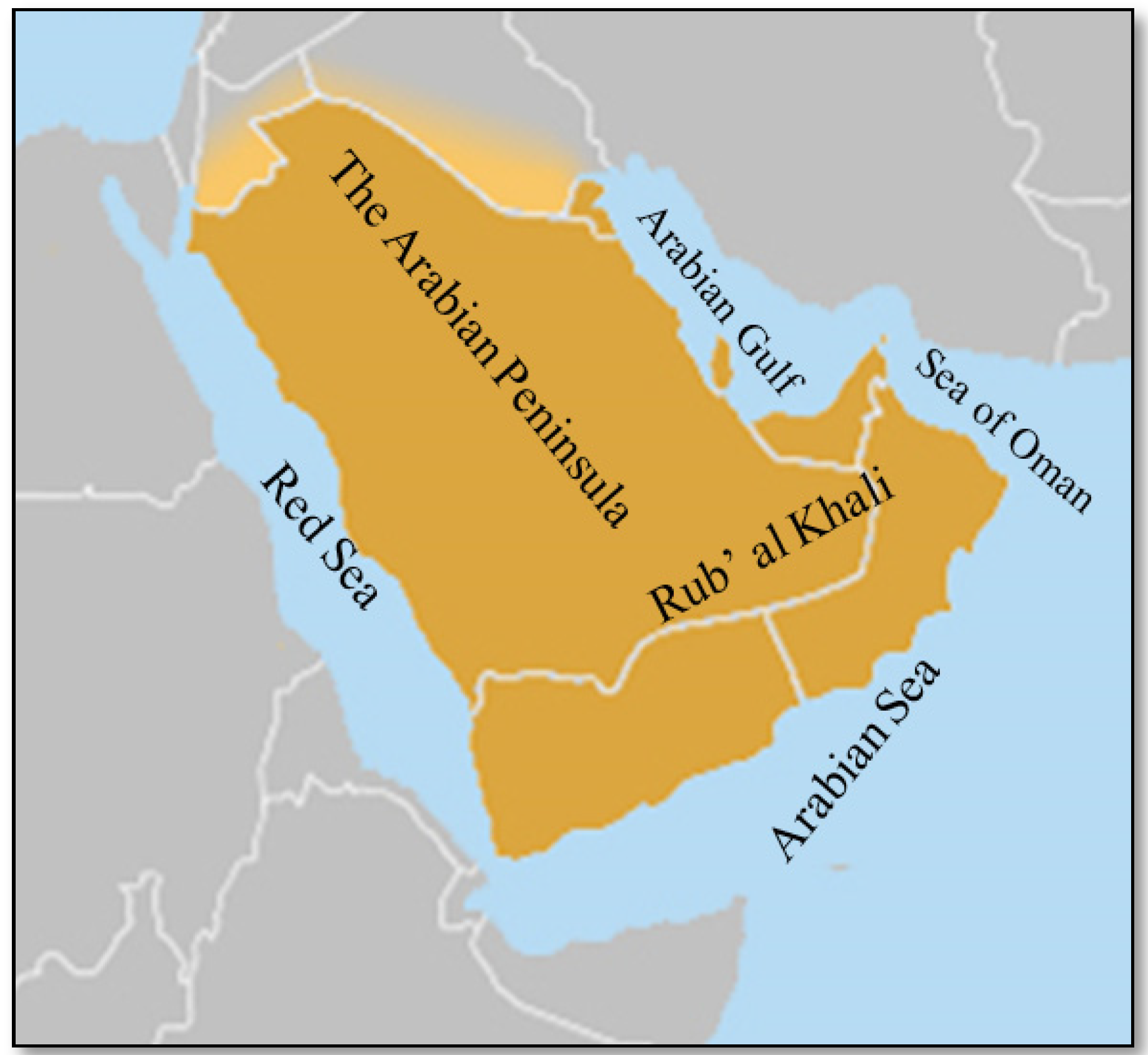
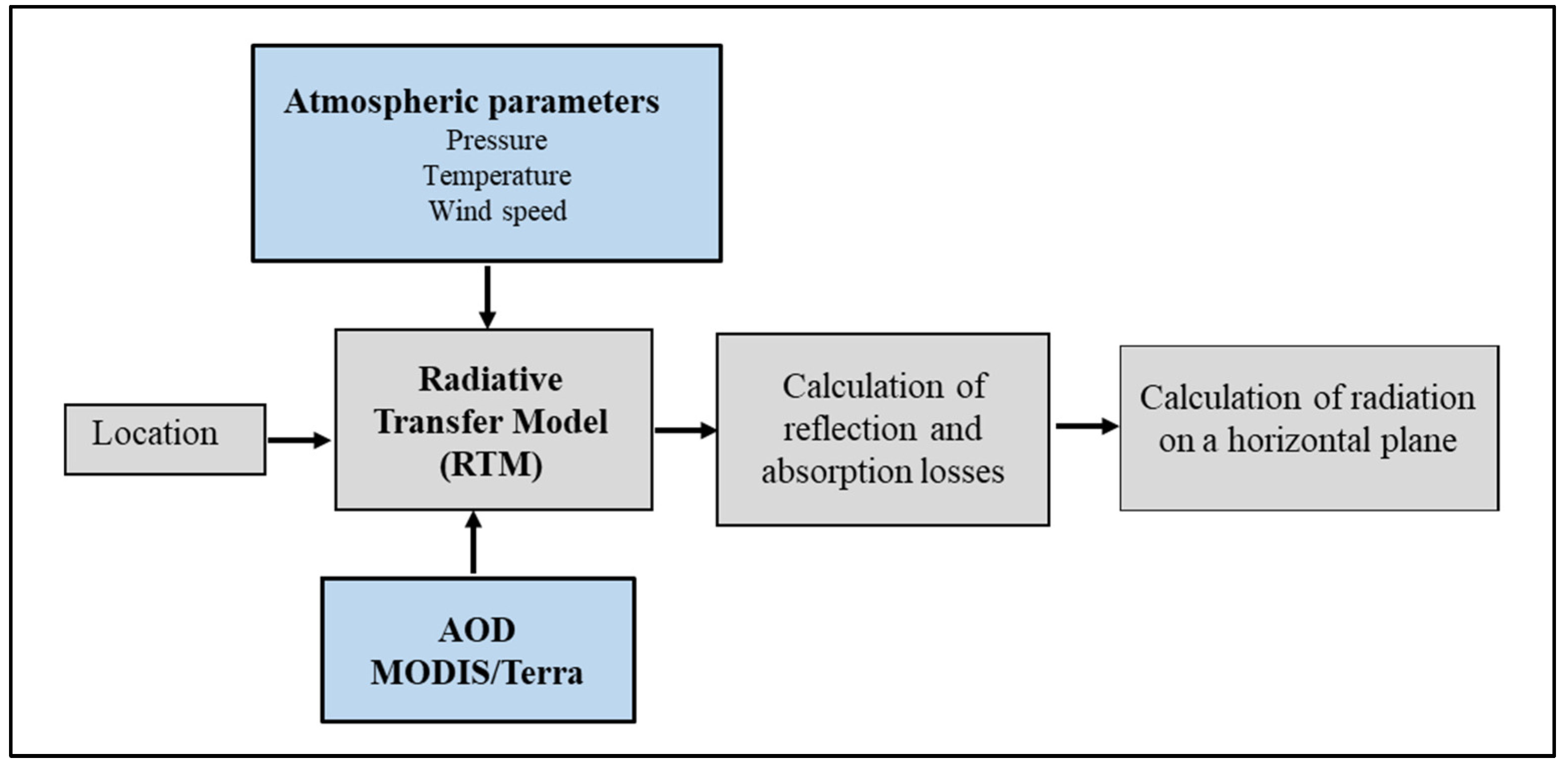
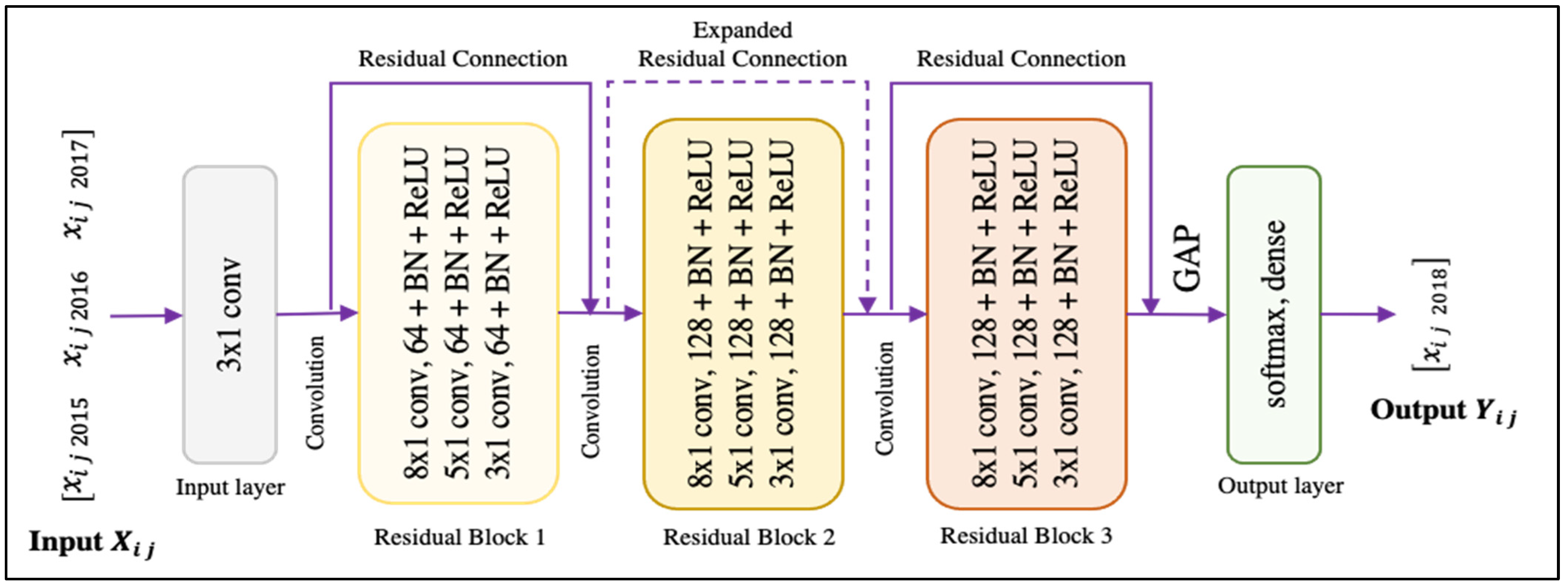


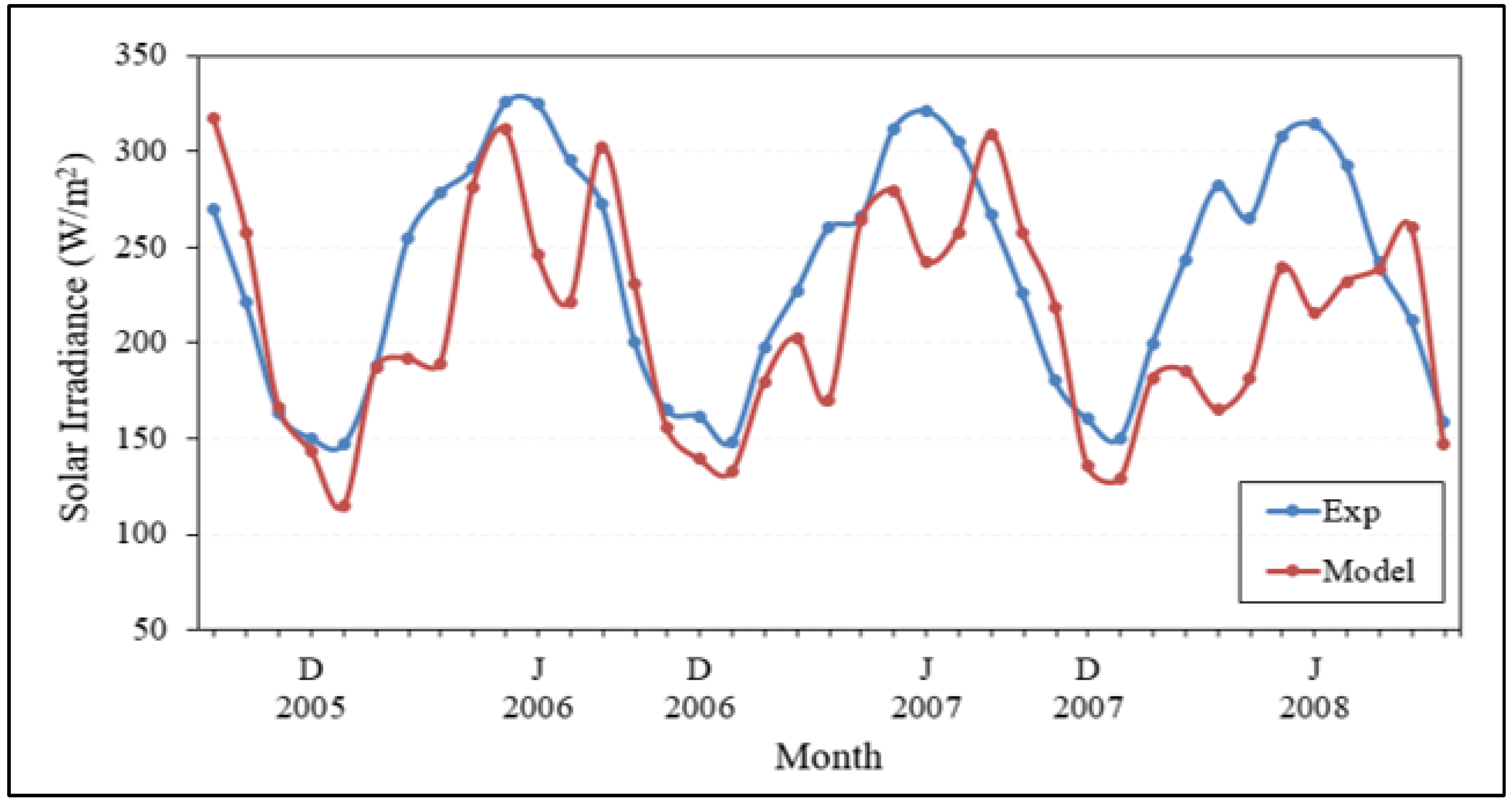
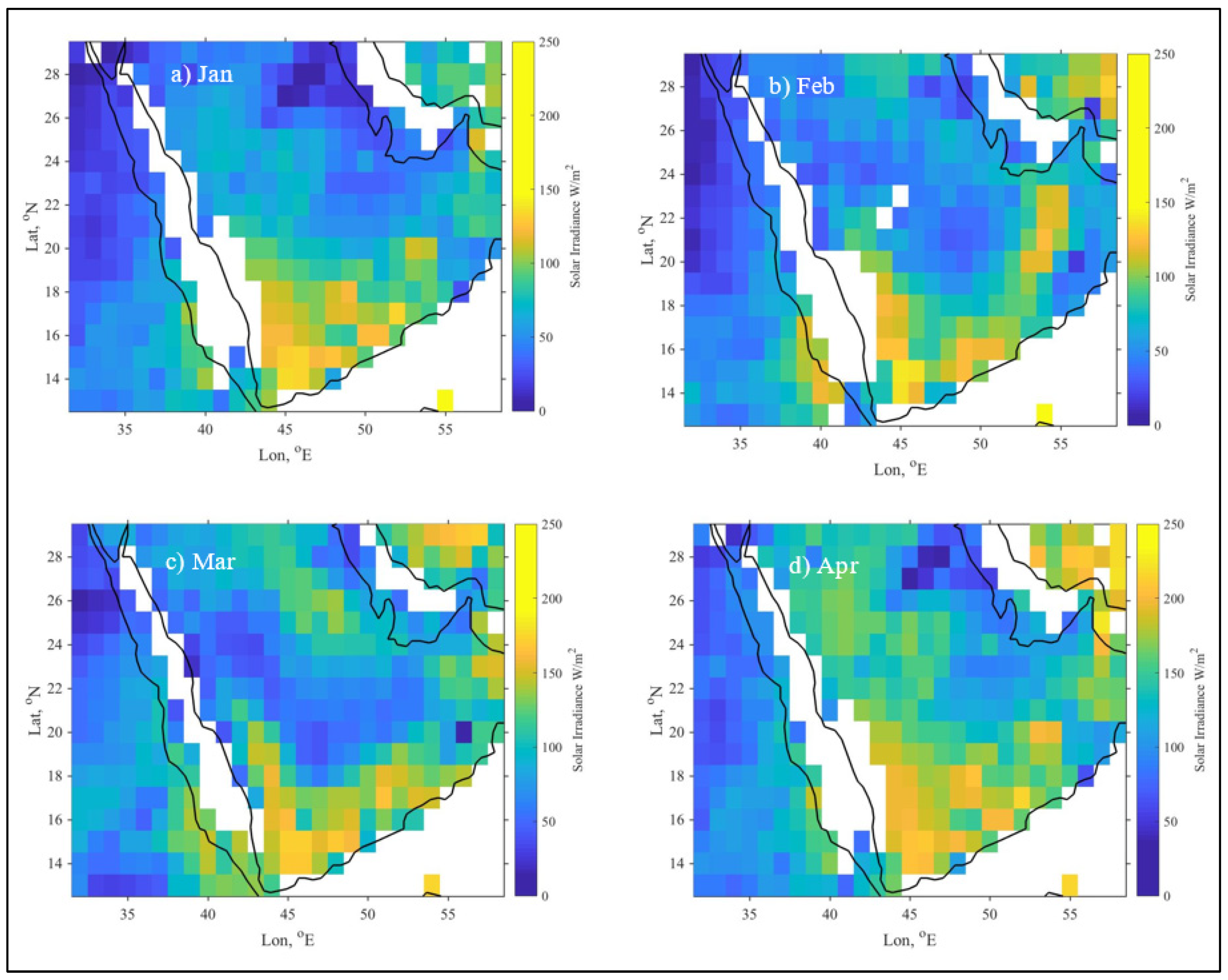

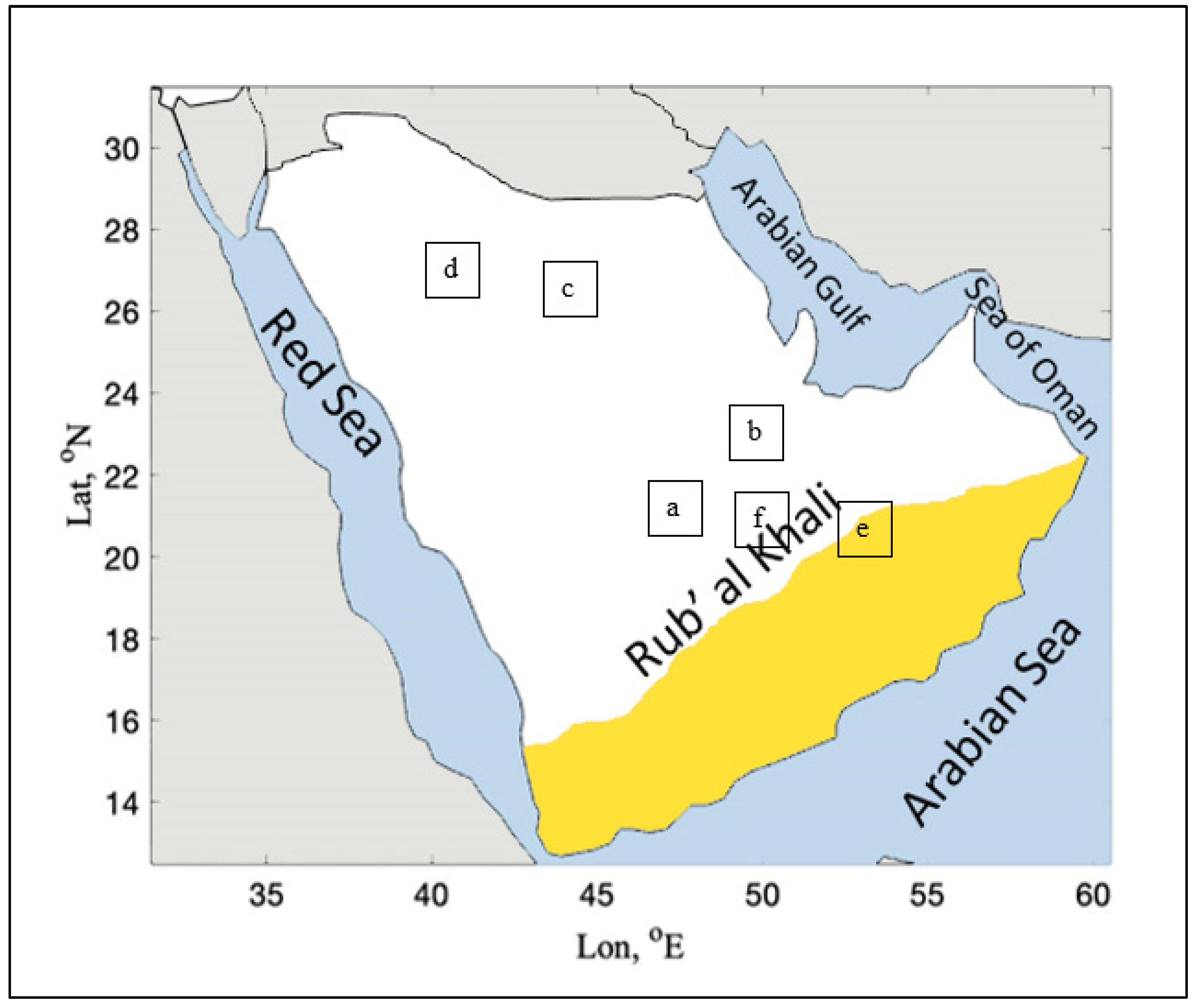
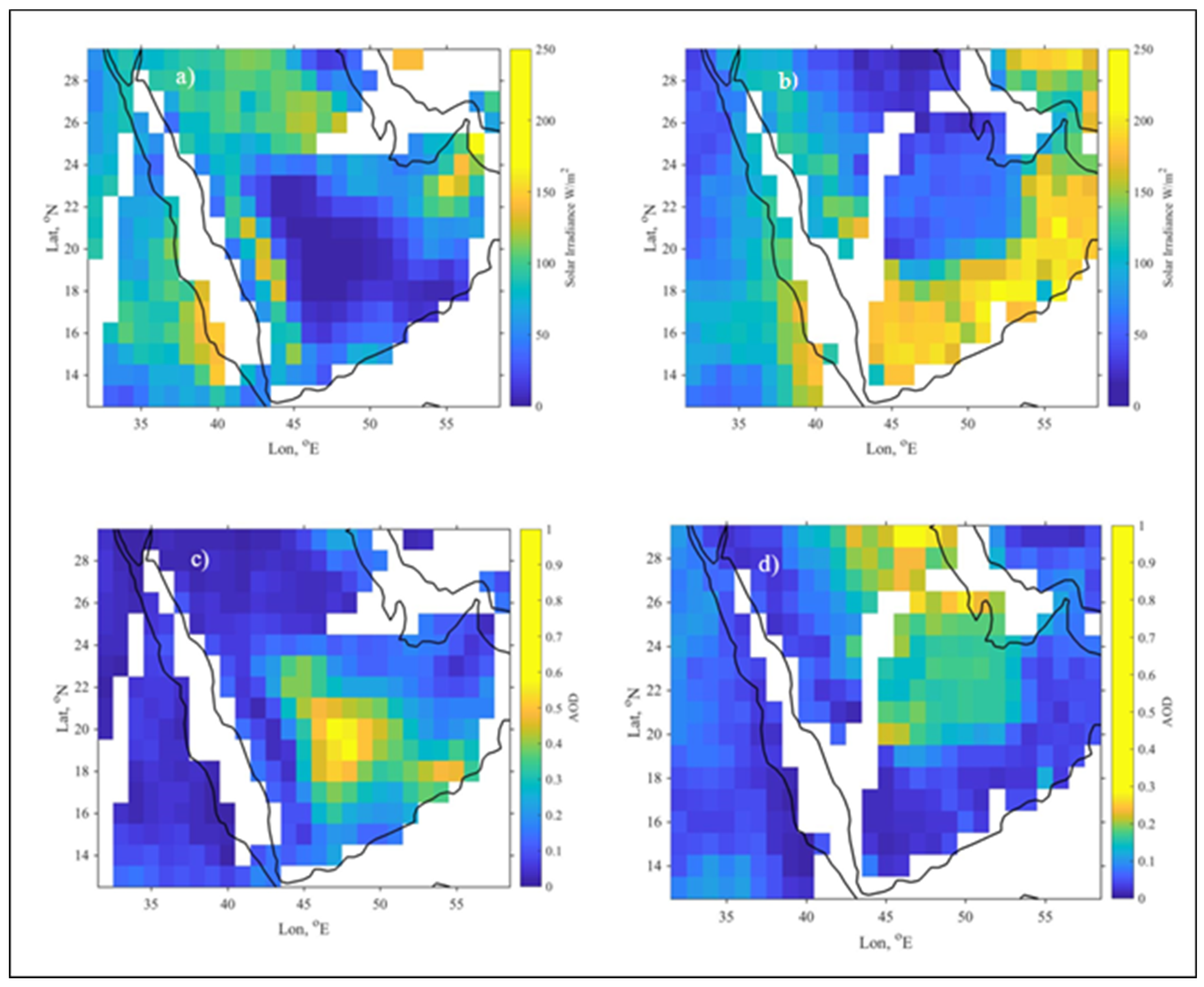
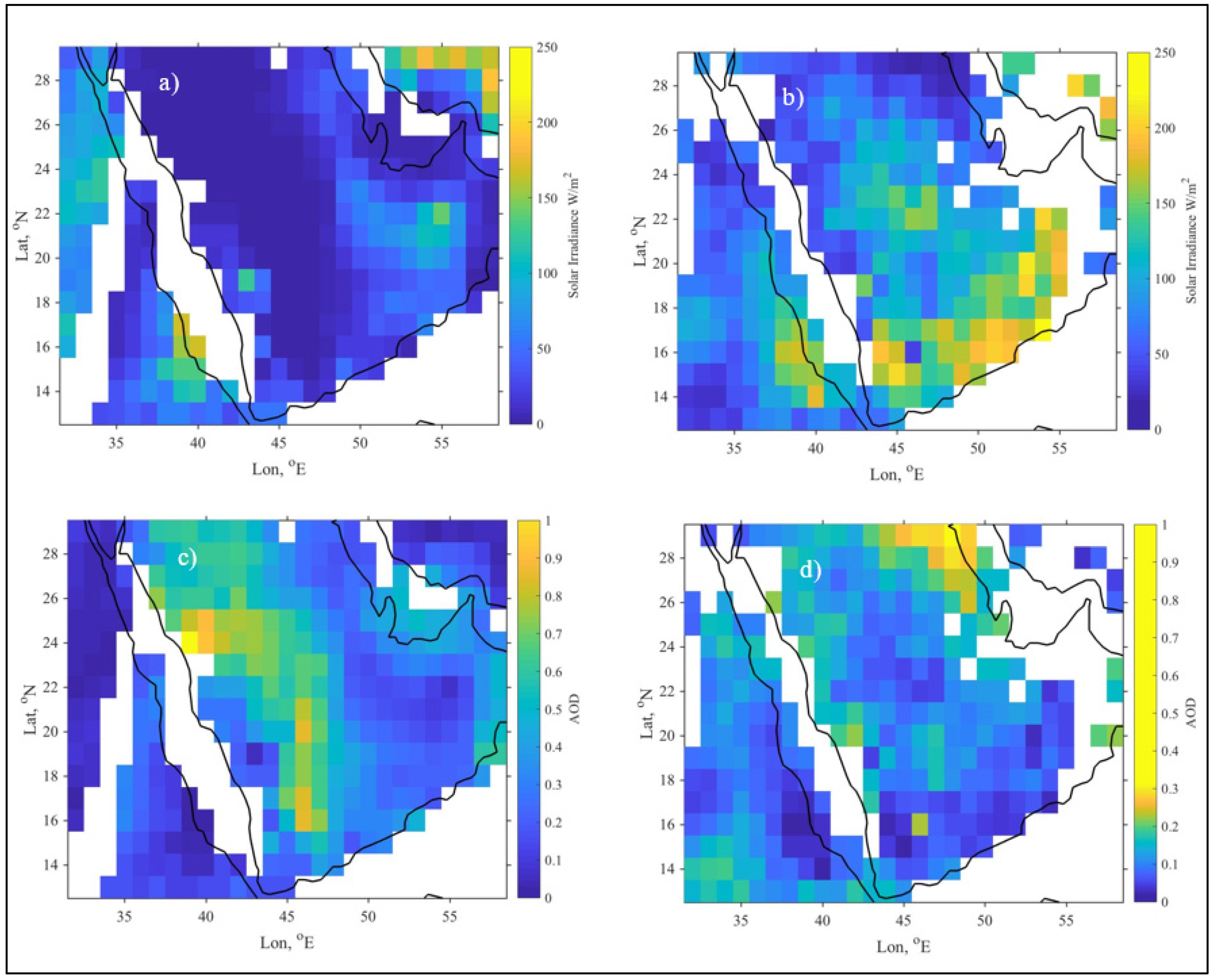
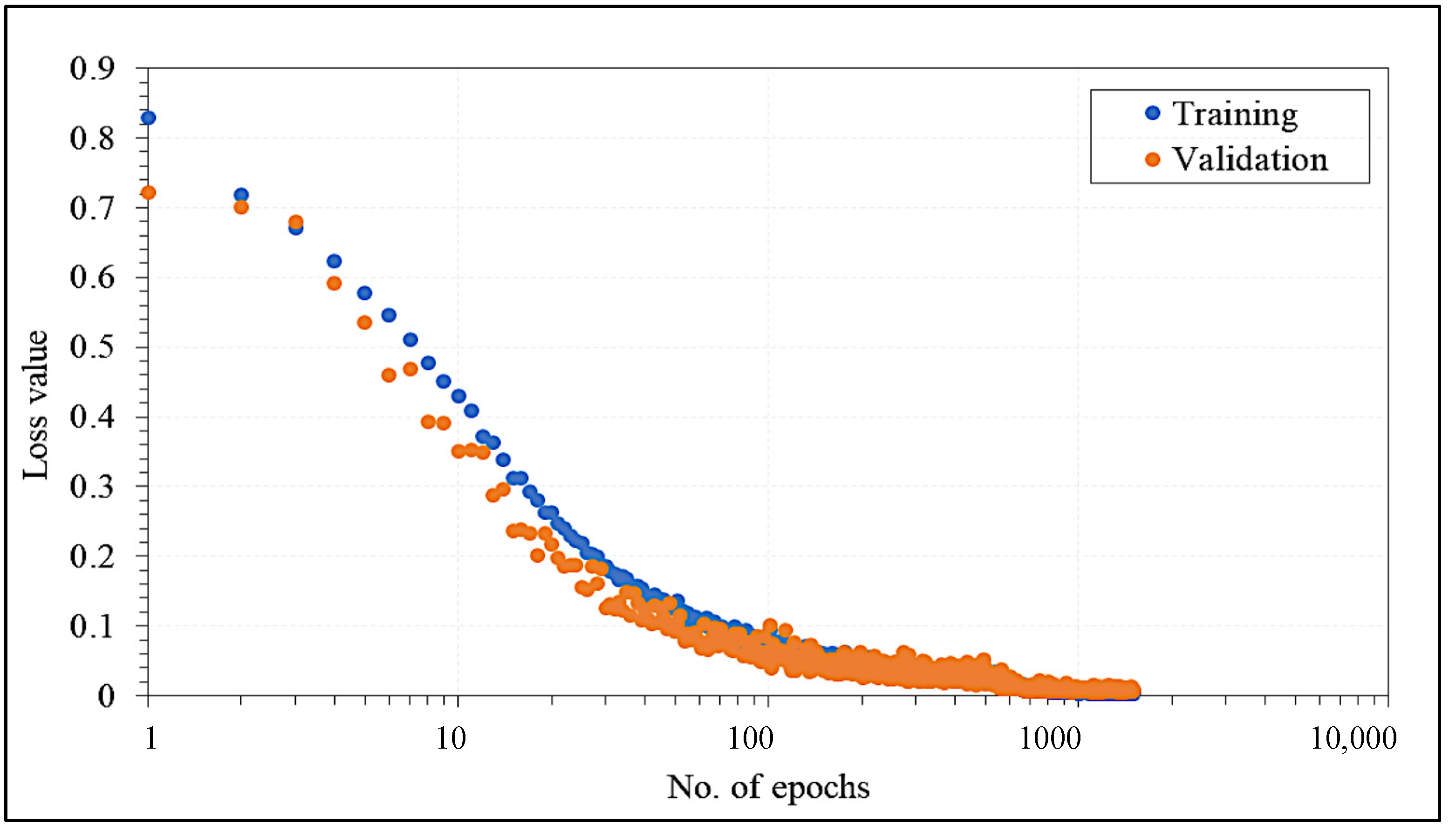

| Parameter | Value | Description |
|---|---|---|
| Filters | 64, 128, 128 | Number of output filters of convolutional layers per block |
| Epochs | 1500 | Number of iterations for training the model |
| Batch size | 64 | Splitting training data into sets of this size |
| Optimization function | Adam | The method used to minimize the loss while training the model |
| Learning rate (LR) | 0.001 | The rate at which the model changes its learning function weights |
| Reduce on plateau | True | Reduce LR if no further improvements |
| Reduction factor | 0.5 | Factor by which LR will be reduced |
| Patience | 50 | Number of epochs plateau before reduction |
| Metric | Formula |
|---|---|
| Mean Squared Error (MSE) | |
| Mean Absolute Error (MAE) | |
| Coefficient of Determination (R2) |
| Year | 2015 | 2016 | 2017 | 2018 |
|---|---|---|---|---|
| Count | 183,960.000000 | 183,960.000000 | 183,960.000000 | 183,960.000000 |
| Mean | 184.534849 | 181.055210 | 180.143084 | 181.290188 |
| Std | 89.289403 | 89.154697 | 92.352037 | 94.513798 |
| Min | 0.088610 | 0.111343 | 0.084850 | 0.089318 |
| Max | 444.175800 | 430.990300 | 465.336600 | 440.987000 |
| Phase | MAE | MSE | R2 | |||
|---|---|---|---|---|---|---|
| No of Testing Data Points | No of Training Data Points | No of Testing Data Points | No of Training Data Points | No of Testing Data Points | No of Training Data Points | |
| 126 | 504 | 126 | 504 | 126 | 504 | |
| Training | 0.026148686 | 0.020791473 | 0.005544215 | 0.006416962 | 0.994715289 | 0.993957559 |
| Testing | 0.026171678 | 0.020798753 | 0.005557584 | 0.006432434 | 0.993304728 | 0.992714978 |
| Overall | 0.024040448 | 0.020051688 | 0.003977843 | 0.005214457 | 0.995350867 | 0.993993272 |
Publisher’s Note: MDPI stays neutral with regard to jurisdictional claims in published maps and institutional affiliations. |
© 2022 by the authors. Licensee MDPI, Basel, Switzerland. This article is an open access article distributed under the terms and conditions of the Creative Commons Attribution (CC BY) license (https://creativecommons.org/licenses/by/4.0/).
Share and Cite
Alwadei, S.; Farahat, A.; Ahmed, M.; Kambezidis, H.D. Prediction of Solar Irradiance over the Arabian Peninsula: Satellite Data, Radiative Transfer Model, and Machine Learning Integration Approach. Appl. Sci. 2022, 12, 717. https://doi.org/10.3390/app12020717
Alwadei S, Farahat A, Ahmed M, Kambezidis HD. Prediction of Solar Irradiance over the Arabian Peninsula: Satellite Data, Radiative Transfer Model, and Machine Learning Integration Approach. Applied Sciences. 2022; 12(2):717. https://doi.org/10.3390/app12020717
Chicago/Turabian StyleAlwadei, Sahar, Ashraf Farahat, Moataz Ahmed, and Harry D. Kambezidis. 2022. "Prediction of Solar Irradiance over the Arabian Peninsula: Satellite Data, Radiative Transfer Model, and Machine Learning Integration Approach" Applied Sciences 12, no. 2: 717. https://doi.org/10.3390/app12020717
APA StyleAlwadei, S., Farahat, A., Ahmed, M., & Kambezidis, H. D. (2022). Prediction of Solar Irradiance over the Arabian Peninsula: Satellite Data, Radiative Transfer Model, and Machine Learning Integration Approach. Applied Sciences, 12(2), 717. https://doi.org/10.3390/app12020717








